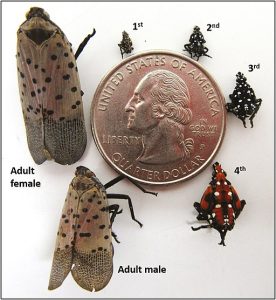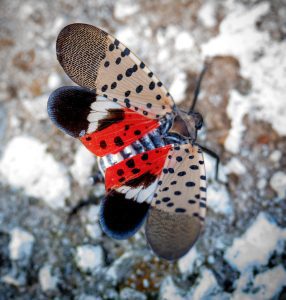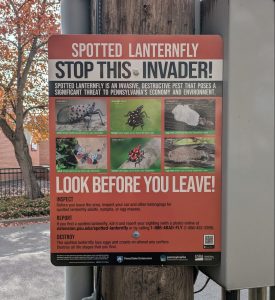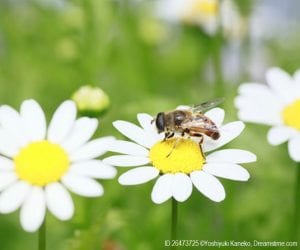This is the first post in a series on invasive species in the U.S. In each post, I’ll explore how the invasive species arrived, the destruction they cause, and what we can all do to help reduce their spread and protect native biodiversity. This blog will focus on the Spotted Lanternfly.
Invasive Species Spotlight: Spotted Lanternfly
 Spotted lanternflies are an invasive species of flying insects that have been wreaking havoc on North America since their arrival. While they may not bite or sting, their insatiable appetite for plant sap is causing millions of dollars in damage. Surprisingly these colorful pests are now one of the most formidable threats to agriculture in the U.S.
Spotted lanternflies are an invasive species of flying insects that have been wreaking havoc on North America since their arrival. While they may not bite or sting, their insatiable appetite for plant sap is causing millions of dollars in damage. Surprisingly these colorful pests are now one of the most formidable threats to agriculture in the U.S.
What is an Invasive Species?
The United States is home to an incredible diversity of native plants and animals. However, not all species currently living here originated here. Since the 1500s, invasive species – non-native plants, animals, and insects that cause economic or environmental harm or harm to human health – have been introduced either accidentally or intentionally.
Once established these species often outcompete native ones for essential resources such as sunlight, water, nutrients and space. As they spread and reproduce, they can cause significant ecological disruption and cost the country billions of dollars annually in damages and control efforts.
 Spotted Lanternfly (Lycorma delicatula)
Spotted Lanternfly (Lycorma delicatula)
Adult spotted lanternflies are about an inch long and have a moth-like appearance. Their outer wings are gray or light brown with black spots, while their striking inner wings are bright red with black spots and contrasting white bands. The abdomen is yellow with bold black bands, and they have black legs and antennae.
Where Did Spotted Lanternflies Come From?
The Spotted Lanternfly (SLF) is a flying insect native to several countries in Asia – specifically, China, India, and Vietnam. The spotted lanternfly was first spotted in the U.S. in Berks County, Pennsylvania in 2014. It is believed that the SLF arrived as egg masses attached to stone on a shipment from China.
Since its arrival in 2014, the invasive spotted lanternfly has rapidly spread beyond Pennsylvania and has now been spotted in a total of 18 states and Washington, D.C.
How Do Spotted Lanternflies Hurt the Environment?
Spotted Lanternflies primarily feed on the sap of the Tree of Heaven, but they are far from selective. These planthoppers target over 70 different species of trees and particularly enjoy the sap from grapevines, often feeding in swarms. As they feed, they excrete their own sap-like substance known as honeydew, which coats plants and nearby surfaces.
The SLF’s honeydew attracts flies, bees, wasps, and other nectar loving insects. The deposit of honeydew on plants creates the perfect environment for the growth of sooty mold and black fungi. The mold and fungi cover leaves, plant stems and tree bark, reducing the plant’s ability to photosynthesize, weakening its health and sometimes leading to plant death. Their tendency to feed in swarms also negatively impacts host tree’s health.
The Economic Impact: How Much do Spotted Lanternflies Cost in Damage?
Beyond the environmental damage, the economic consequences of spotted lanternflies are growing. The damage SLF’s cause results in reduced crop yields and quality of fruit. Here are some of the economic impacts seen across various states:
Pennsylvania
SLF infestations could cost Pennsylvania at least $324 million annually and lead to the loss of about 2,800 jobs, particularly in forestry, agriculture, and related industries. (Penn State, College of Agricultural Sciences)
New York
The New York grape and wine industry is particularly vulnerable to spotted lanternflies, especially in the Lake Erie and Finger Lakes region. Studies estimate SLF-related damage could cost the state’s grape industry $1.5, $4, and $8.8 million in the first, second, and third years of infestation. (Journal of Integrated Pest Management)
Virginia
Experts warn that Virginia’s $8 billion dollar wine industry could be severely impacted as well as the state’s beekeeping operations. (Washington Post) Honey produced from bees feeding on SLF honeydew can develop an off-putting dark color and “earthy” taste, potentially lowering its market value.
These are just a few examples, but the broader picture is clear: without effective control, spotted lanternflies pose a serious threat to U.S. agriculture, forestry, and native ecosystems, with billions of dollars at stake across multiple industries and regions.
Be a Steward of Native Ecosystems
Stopping the spread of Spotted Lanternflies is a shared responsibility and an important one. Below are what some states are doing, and how you can make a difference too.
State-Level Actions Against the Spotted Lanternfly
States affected by spotted lanternflies are taking a multi-pronged approach to control the invasive pest.
Quarantined Zones: Many have established quarantine zones to restrict the movement of goods and materials that could carry lanternfly eggs or adults, helping to slow their spread.
Community Involvement: Public awareness campaigns are also playing a crucial role, with states encouraging residents to report sightings and take steps to kill the insects when possible.
Direct Control Measures: Some areas are using targeted pesticide applications and tree banding to reduce local populations.
Ways You Can Help Stop the Spotted Lanternfly
There are many simple, everyday actions we can take to help slow the spread of this invasive insect –most of which are free and easy to do.
 Kill on Sight: It is recommended to kill SLF at all stages of life (eggs, nymphs, and adults). Nymphs and adults can and should be squished or stomped on.
Kill on Sight: It is recommended to kill SLF at all stages of life (eggs, nymphs, and adults). Nymphs and adults can and should be squished or stomped on.
Destroy Egg Masses: If you spot SLF egg masses on trees, fences, vehicles or outdoor furniture, scrape them into a sealable plastic bag or container using a credit card or similar object, fill with rubbing alcohol or soapy water then seal and discard.
Report Infestations: Contact your local Parks and Recreation office or your State’s Department of Agriculture to report infestations.
Check Before You Transport: Egg masses are often laid on cars and firewood. Be sure to check outdoor items before moving them between locations.
Use Approved Herbicides and Pesticides: Because SLF have been around the United States for over a decade now, there are specialized sprays that can be found at garden stores that will help to kill and deter the flies. Hornet and wasp sprays also work well.
Stopping the Spotted Lanternfly
Although many find spotted lanternflies beautiful and thus difficult to kill, it is crucial for the sake of our natural biodiversity, agriculture, and economy that we work together to slow their spread. Fortunately, some native animals and insects are beginning to prey on SLFs, which may also help control their populations over time.
Image credits: Lanternfly life cycle (Published by Oxford University Press on behalf of Entomological Society of America 2021, Public domain, via Wikimedia Commons); Spotted lanternfly displaying wings (WanderingMogwai, CC BY-SA 4.0, via Wikimedia Commons); Spotted lanternfly infestation map (Spotted Lanternfly Map by Cornell Integrated Pest Management)




